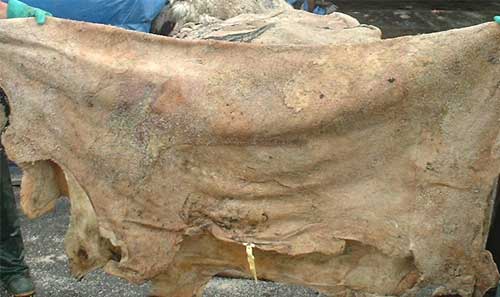A Pre-Christian Custom in Eighteenth-Century Scotland? April 26, 2014
Author: Beach Combing | in : Medieval, Modern , trackbackA recent article on Chris’ Haunted Ohio Books quoted an eighteenth-century source for an unusual form of Scottish divination: the whole passage (from Martin Martin, obit 1718) is well worth reading, as is Chris’ thoughts on the same. But one bit particularly stood out: it relates to the Hebrides.
The second way of consulting the Oracle was, by a Party of Men, who first retired to Solitary Places, remote from any House, and there they singled out one of their Number, and wrap’d him in a big Cows Hide which they folded about him, his whole Body was covered with it except his Head, and so left in this Posture all night until his invisible Friends reliev’d him, by giving a proper Answer to the Question in hand which he received, as he fancied, from several Persons that he found about him all that time, his consorts return’d to him at break of Day, and then he communicated his News to them, which often proved fatal to those concerned in such unwarrantable enquiries.
This is the kind of custom that excites historians because they think that they might have here a glimpse of a pre-Christian Gaelic customs. Usually, when historians the word ‘pre Christian’ in a modern context then you are well advised to shut the book with a bang. But in this instance, there is a good chance that they are actually correct. The evidence is patchy but exciting. The Gaelic antiquarian Keating in the sixteenth century claims that the Irish druids used to employ ox hides for their magic and implies that they laid down on them; there is an early medieval Irish source that connects cows with prophecy, though it seems to involve eating. Then, most excitingly, there is a twelfth century (or possibly thirteenth) Welsh tale in the so-called Mabinogi collection, entitled the Dream of Rhonabwy
And they went to sleep. Rhonabwy’s two companions fell into a deep sleep, after the fleas and discomfort had tormented them. But Rhonabwy, since he could neither sleep nor rest, thought he would suffer less if he went to sleep on the yellow ox-skin on the dais. And there he slept. And soon as sleep entered his eyes he was granted a vision, that he and his companions were travelling across Maes Argyngroeg, and his inclination and intent, so he thought, was towards Rbyd-y-groes
The Dream is a strange story: it seems to be a parody of a Welsh romance, something hard to judge as we don’t have too many medieval Welsh romances; imagine if the only bit of twenty-first century life to survive was Portlandia. But parody or not there is apparently an allusion to a medieval custom here. Rhonabwy can’t sleep and foolishly pulls the ox-skin down and lies in it not realizing that he is accidentally creating vision magic. He then has that vision and, the storyteller informs us that he wakes after three days and three nights, having seen many weird and wonderful things.
There are also other scattered early references from Euro-Africa-Asia of animal pelts transmitting visionary power: from China and nearer home both Ovid and Virgil seem to carry references. Why? It is sometimes noted in early modern references from Scotland that the hide of the animal should be from a newly killed animal (the visionary was presumably wrapped in blood): there was, then, a sacrifice perhaps originally? Or/and was the visionary pretending to be the dead animal finding his way into the otherworld? We may have in the reference quoted by Chris one of the last examples of a ritual that dates back to pre-Christian times, and perhaps even back into the Neolithic. Drbeachcombing At yahoo DOT com



